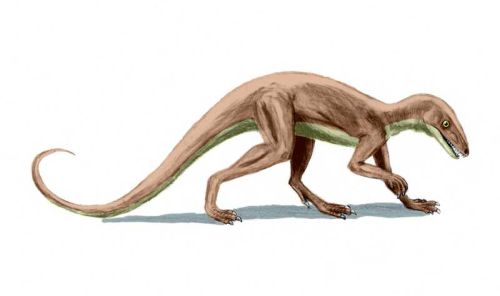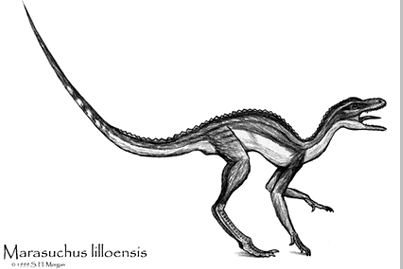
| Palaeos |  |
Dinosauria |
| Vertebrates | Dinosauriformes |
| Page Back | Unit Home | Unit Dendrogram | Unit References | Taxon Index | Page Next |
| Unit Back | Vertebrates Home | Vertebrate Dendrograms | Vertebrate References | Glossary | Unit Next |
|
Abbreviated Dendrogram
ARCHOSAURIA |--CROCODYLOMORPHA `--+--PTEROSAURIA | `--DINOSAUROMORPHA |--Lagerpeton |--Lagerpeton `--Dinosauriformes |--Lagosuchidae `--+--Silesauridae `--Dinosauria |--ORNITHISCHIA `--Saurischia |--SAUROPODOMORPHA `--THEROPODA |
Contents
Overview |
 Lagosuchus talampayensis (= Marasuchus), Ladinian of South America, reconstruction based on Bonaparte, 1975 Artwork by Nobu Tamura, via Wikipedia, GNU Free Documentation/Creative Commons Attribution Share Alike |
 Dinosauriformes:
Lewisuchus (= Pseudolagosuchus).
Dinosauriformes:
Lewisuchus (= Pseudolagosuchus).
Range: fr mT.
Phylogeny: Dinosauromorpha: Lagerpeton + *: Lagosuchidae + (Silesauridae + Dinosauria).
Characters: shortened forelimbs; $ at least partially perforated acetabulum (??); enlarged supraacetabular ridge; primitively, acetabulum remained relatively large compared to femoral head; $ antitrochanter on posterior wall of acetabulum (primitively small); $ extension of femoral articular surface under head of femur (?); $ proximal femur with fossa trochanterica and trochanteric shelf; $ anterior (lesser) trochanter on femur; $ trochanteric shelf on proximal femur; $ cnemial crest present on proximal tibia; $ quadrangular distal tibia with lateral longitudinal groove; $ posterior flange on the distal end of tibia.
Links: Untitled Document; Dinosaur Monophyly; Dinosaurian Precursors.
References: Hutchinson & Gatesy (2000); Novas (1996); Sereno & Arcucci (1994). 010323.
Lagosuchidae: Marasuchus (= Lagosuchus).
Range: mT of SAm.
Phylogeny: Dinosauriformes: (Dinosauria + Silesauridae) + *.
 Characters:
Small (<0.5m), gracile, bipedal proto-dinosaurs. Elongated snout with
numerous, small teeth; long, S-shaped neck; vertebrae sharply regionalized (i.e.
cervical, ant. dorsal, post. dorsal, & caudal); spines of dorsal vertebrae
may incline anteriorly (said to be associated with saltatorial habit);
acetabular fenestration minor or absent; posterior limbs much longer than
anterior; tibia longer than femur; head of femur points toward midline, but
femur may be somewhat sigmoid (Lagerpeton); fibula reduced sharply,
limiting rotation at knee; calcaneum reduced relative to astragalus; calcaneal
heel absent; dinosaur-like mesotarsal hinge between astragalus & calcaneum
and between proximal and distal tarsals; but proximal tarsals not integrated
with crus; metatarsals II-IV very long & closely appressed; 5th digit not
hooked; fully erect posture; very likely obligate bipeds; may have line of
dorsal scutes.
Characters:
Small (<0.5m), gracile, bipedal proto-dinosaurs. Elongated snout with
numerous, small teeth; long, S-shaped neck; vertebrae sharply regionalized (i.e.
cervical, ant. dorsal, post. dorsal, & caudal); spines of dorsal vertebrae
may incline anteriorly (said to be associated with saltatorial habit);
acetabular fenestration minor or absent; posterior limbs much longer than
anterior; tibia longer than femur; head of femur points toward midline, but
femur may be somewhat sigmoid (Lagerpeton); fibula reduced sharply,
limiting rotation at knee; calcaneum reduced relative to astragalus; calcaneal
heel absent; dinosaur-like mesotarsal hinge between astragalus & calcaneum
and between proximal and distal tarsals; but proximal tarsals not integrated
with crus; metatarsals II-IV very long & closely appressed; 5th digit not
hooked; fully erect posture; very likely obligate bipeds; may have line of
dorsal scutes.
 |
| Marasuchus lilloensis © 1999 by SH Morgan. Used by permission. |
Discussion: The literal meaning of "lagosuchid" is, as Robert Bakker is fond of pointing out, "rabbit-croc." It would be interesting to know if they were actually saltorial, that is jumpers, like rabbits. The ability to use jumping as a routine means of locomotion leaves its mark on the skeleton, but the indications in the Lagosuchidae are ambiguous. Some common indications of a jumping animal are as follows:
1) elongation and fusion of the phalanges (toe bones) and metatarsals (foot bones). Here, the toes and metatarsals are quite long, but there is no evidence of fusion.
2) hind limbs 2-4 times as long as front limbs. Lagosuchids are marginal.
3) center of gravity shifted posteriorly. Its hard to tell from skeletal remains alone. Perhaps the answer is "somewhat." The pelvis, in particular, suggests a design which maximizes the amount of posterior mass. However, this is not nearly the same degree of back-heaviness seen in a frog, rabbit, or kangaroo.
4) small head or stiffened or fused cervical spine. The head is not well known for any lagosuchid. Marasuchus, at least seems to have had a relatively small head and the cervical vertebrae are notably longer and deeper than the dorsal vertebrae, suggesting that the neck was less laterally flexible and may have been tightly bound with tendons. This impression is reinforced (as was the neck) by the presence of fairly long cervical ribs.
On the whole it seems likely that Lagosuchids were accomplished jumpers, although perhaps not as specialized for this locomotor style as rabbits. A reasonable speculation might be that they were ambush predators who used a leaping attack, but did not use repeated jumping in routine locomotion. The latter style is referred to as "ricochetal." The efficiency of ricochetal locomotion (which is very high) depends on the ability to store the kinetic energy of one leap and to use that energy to take off on the next leap. This is typically accomplished by stretching stiff tendons in the leg or foot on landing, or deforming bone, which "snaps back" to act as a propulsor on the next jump. There is no obvious sign that the lagosuchids possessed such a mechanism, although it might be very difficult to determine its presence or absence from skeletal remains alone. Given recent work on the origin of powered flight, the answers to these questions may be of more than casual interest. (ATW 000830)
Links: DinoData: Lagosuchidae; dinosauromorpha; Dinosaurian Precursors; Marasuchus -- The Dinosauricon.
References: Arcucci (1997); Carroll (1988); Garner et al. (1999); Padian (1997). 000829.
| Page Back | Unit Home | Page Top | Page Next |
checked ATW031023, page last modified MAK120206